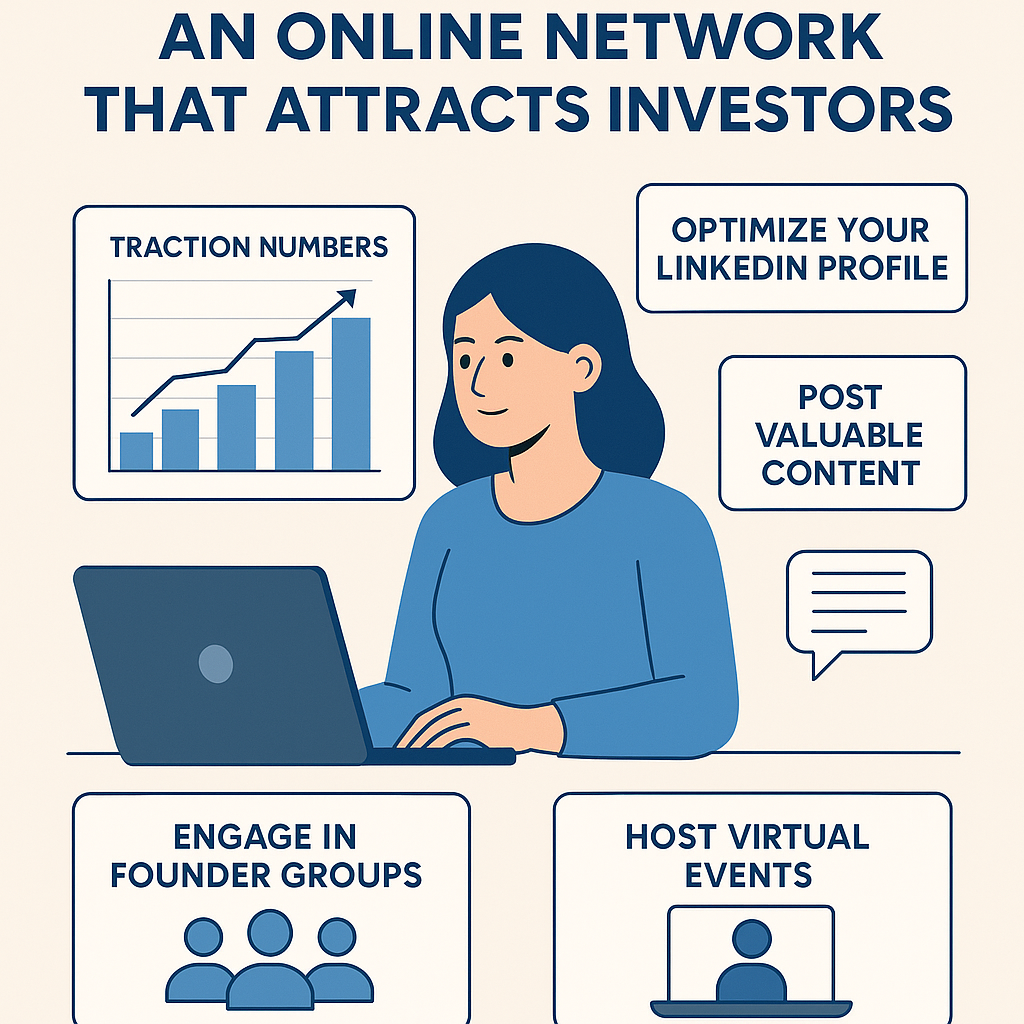How to Build an Online Network That Attracts Investors
How to Build an Online Network That Attracts Investors

Why Investors Now Source Startups in Online Communities
Investors no longer rely only on pitch events or cold email decks.
They spend hours in online communities looking for promising founders.
Why? Because communities show traction before the pitch.
When you engage in niche networks, investors see your credibility in real time.
They see how you answer questions, share insights, and collaborate.
That builds trust before you ever ask for funding.

Example: Many VCs scout in SaaS-focused Slack groups because active participation shows expertise.
For more on how the fundraising landscape has changed, see our blog post: Raising Capital in 2025: The Complete Founder’s Playbook.
Choosing the Right Networking Platforms for Founders
Not all platforms are worth your time.
Focus on where investors actually hang out.
Here’s a breakdown:
- LinkedIn – Best for professional branding and inbound investor interest.
- AngelList – Great for fundraising visibility.
- Slack/Discord – Strong for niche founder-to-founder and founder-to-investor discussions.
- Twitter/X – Fast for thought leadership and trend discussions.
For more on platform strategy, see our blog post: Investor Metrics That Matter: A Founder’s 2025 Guide.
Optimizing Your LinkedIn Profile to Attract Investors
Your LinkedIn is your investor landing page.
Make it conversion-ready:
- Headline: Show traction + niche. Example: “Founder of AI SaaS with 500K ARR.”
- About section: State your mission, traction, and vision in under 5 sentences.
- Featured: Add press mentions, pitch deck, and customer wins.
- Recommendations: Get endorsements from industry leaders.
Using LinkedIn Content to Build Founder Authority
Investors follow founders who teach and lead.
Post insights about your industry, not just funding updates.
Formats that work:
- Quick frameworks you’ve used to grow.
- Case studies from your customer wins.
- Commentary on industry news.
For more content tips, see our blog post: The Ultimate Guide to Pitch Decks for Startup Fundraising.
Joining High-Value Slack & Discord Startup Groups
Closed groups often have higher investor density.
Look for communities with active deal flow channels.
When joining:
- Introduce yourself with traction stats.
- Add value before asking for intros.
- Keep your pitch short and link to a deck.
Engaging in Niche Founder Forums and Communities
Places like Indie Hackers or Y Combinator’s forum can be goldmines.
The key is consistency.
Comment on other founders’ posts weekly.
Share your learnings in public.
Hosting Virtual Events to Attract Investor Attention
Webinars and AMAs (Ask Me Anything) are powerful.
When you host, you control the narrative.
Invite investors to speak as panelists — they’ll remember you.
For more on event-based networking, see: How to Negotiate Your First Term Sheet Like a Pro.
Podcasting as a Founder Brand-Building Tool
Podcasts build authority fast.
Interview other founders and investors.
You create an excuse to start relationships with high-value guests.
Building an Investor Email Newsletter That Converts
An investor-focused newsletter keeps you top-of-mind.
Send monthly updates with:
- Traction numbers.
- New hires.
- Industry insights.
Collaborating with Other Startups in Your Niche
Co-marketing partnerships expand reach.
Host joint events.
Cross-promote on social media.
If they have investor followers, you’re indirectly networking.
How to Turn Online Connections into Warm Introductions
The fastest way to a meeting is through trust transfer.
When you meet someone online:
- Build rapport over weeks, not hours.
- Ask for advice before asking for money.
- When you request an intro, make it frictionless with a short blurb.
Engaging in Twitter/X Conversations Investors Watch
Follow the top 20 investors in your niche.
Engage with their posts daily.
Add value in comments — not just “Great post.”
AI Tools That Help You Manage Investor Relationships
Use AI CRMs like Clay, Folk, or Affinity to track interactions.
Set reminders for follow-ups.
Automate investor updates with personalized AI-driven email drafts.
For more on AI in fundraising, read: 15 AI-Powered Fundraising Tools Every Founder Should Know.
The Power of Community Case Studies in Attracting Capital
When you share case studies inside your network, investors see proof.
Example: Posting “How we 3x’d ARR in 6 months” in a founder group can lead to a DM from a VC.
Scaling Your Network Without Losing Personal Touch
Use systems to stay personal at scale:
- Tag contacts by category in your CRM.
- Send quick voice notes on LinkedIn instead of long messages.
- Celebrate small wins of your network members publicly.
FAQs
1. How long does it take to build an online investor network?
Usually 6–12 months of consistent effort.
2. Should I pay to join private investor groups?
Only if the group has proven deal flow and vetted members.
3. Do investors respond to cold LinkedIn messages?
Yes, if they’re personalized and backed by traction.
4. How do I track investor conversations?
Use AI-powered CRMs or even a simple spreadsheet with follow-up dates.
5. Is Twitter/X still relevant for startup networking?
Yes — especially for sectors like AI, SaaS, and fintech.
6. Should I send my pitch deck on first contact?
No — first get interest, then share on request.
7. How many platforms should I focus on?
Two to three max to avoid spreading too thin.
8. Do podcasts actually bring investor leads?
Yes, if you target your guest list strategically.
9. Can I build an investor network without prior funding experience?
Absolutely — start by sharing valuable industry insights.
10. What’s the biggest networking mistake founders make?
Asking for money before building trust.
Conclusion
Building an online network that attracts investors isn’t about luck.
It’s about being where they are, showing traction, and building trust before the ask.
Use the right platforms, create valuable content, and maintain personal touch at scale.
If you apply these principles, your online presence will pull investors toward you — not the other way around.
Subscribe to Capitaly.vc to raise capital at the speed of AI.


.png)